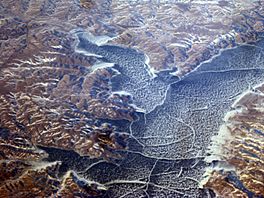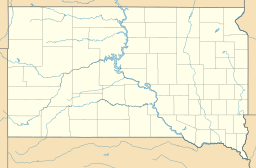Lake Oahe facts for kids
Quick facts for kids Lake Oahe |
|
|---|---|

Lake Oahe in winter, 2009
|
|
| Location | South Dakota and North Dakota, United States |
| Coordinates | 44°27′04″N 100°24′08″W / 44.45111°N 100.40222°W at Oahe Dam |
| Lake type | reservoir |
| Primary inflows | Missouri River, Cheyenne River, Moreau River, Grand River |
| Primary outflows | Missouri River |
| Max. length | 231 mi (372 km) |
| Surface area | 370,000 acres (150,000 ha) |
| Max. depth | 205 ft (62 m) |
| Water volume | 23,500,000 acre⋅ft (29.0 km3) |
| Shore length1 | 2,250 mi (3,620 km) |
| Surface elevation | 1,647 ft (502 m) |
| Settlements | Pierre, South Dakota, Fort Pierre, South Dakota, Mobridge, South Dakota, Pollock, South Dakota, Fort Yates, North Dakota, Cannon Ball, North Dakota, Bismarck, North Dakota |
| 1 Shore length is not a well-defined measure. | |
Lake Oahe is a very large reservoir (an artificial lake) in the United States. It was created by the Oahe Dam on the Missouri River. This huge lake stretches from central South Dakota all the way north into North Dakota.
Lake Oahe covers about 370,000 acres (1,500 km2) and is up to 205 ft (62 m) deep. It is the fourth-largest reservoir in the entire US by the amount of water it holds. The lake is about 231 mi (372 km) long and has a shoreline of 2,250 mi (3,620 km). Many people visit Lake Oahe each year, with 51 special areas set up for fun activities. The lake got its name from the Oahe Indian Mission, which was established in 1874.
Lake Oahe starts just north of Pierre, South Dakota. It reaches almost as far north as Bismarck, North Dakota. The town of Mobridge, South Dakota is located on the eastern side of the lake. You can cross Lake Oahe on bridges like US Route 212 near Gettysburg, South Dakota and US Route 12 at Mobridge.
Before the lake was made, a town called Forest City was located where the water now is. It was flooded when the dam was built. Scientists have also found very old archaeological sites in the area. One important site is Molstad Village near Mobridge. It shows how people lived long ago, even before the Arikara, Hidatsa, and Mandan tribes became separate groups. This site is so important that it's called a National Historic Landmark.
Contents
Fun Activities at Lake Oahe
Lake Oahe is a great place for outdoor fun! Many different kinds of fish live here, like walleye, northern pike, channel catfish, and smallmouth bass. There are also Chinook salmon, which are usually found in the Pacific Northwest. These salmon are raised and released into the lake, making them a popular catch for people who love to fish. The lake is also home to the endangered pallid sturgeon, a special type of fish.
There are 50 public areas around Lake Oahe where you can enjoy the water. Many of these spots have places to launch boats, marinas, campgrounds, and picnic areas. You can also find hiking trails and places for hunting and fishing.
Native American History and Culture
The western shore of Lake Oahe is part of the Cheyenne River Indian Reservation and the Standing Rock Indian Reservation. These are lands belonging to Native American tribes.
Two possible burial sites of Sitting Bull, a famous Sioux leader, are located near Lake Oahe. One is near Fort Yates, North Dakota, and the other is near Mobridge.
The land around Lake Oahe holds many important items and places that tell us about the history of Native American tribes. These tribes have lived and traveled through the Missouri River area for a very long time. It is against the law to collect or damage any old items, including fossils. The U.S. Army Corps of Engineers and Native American tribal police work together to protect these important cultural sites. They use laws like the Antiquities Act and the Native American Graves Protection and Repatriation Act to make sure these sites are safe. Breaking these laws can lead to serious penalties.
Building the Dam and Its Impact
In the 1960s, the Army Corps of Engineers built several large dams on the Missouri River, including the Oahe Dam. These dams were part of a big plan to control the river. However, building the Oahe Dam caused over 200,000 acres of land on the Standing Rock and Cheyenne River Reservations to be flooded. This meant that many Native American families had to move from their homes and traditional lands.
Even today, many of these families face challenges because they lost their homes and traditional ways of life. They are still working to get fair support for what they lost when the lake was created.
Dakota Access Pipeline and Lake Oahe
Lake Oahe became a central point in protests against the Dakota Access Pipeline. This pipeline project was debated because of worries about its possible effects on the environment. Several Native American tribes, including different Sioux nations, were against the pipeline crossing under Lake Oahe. They were concerned about their water supply and sacred lands.
In 2016, a group from the Standing Rock Indian Reservation asked the U.S. Army Corps of Engineers (USACE) to stop the project. For a while, the USACE decided not to allow the pipeline to cross under Lake Oahe. They wanted to study other possible routes for the pipeline.
However, in early 2017, the USACE changed its decision and approved the pipeline's path under Lake Oahe. Soon after, the Cheyenne River Sioux tribe filed a lawsuit. They argued that the pipeline would go against an old treaty and interfere with their religious practices.



